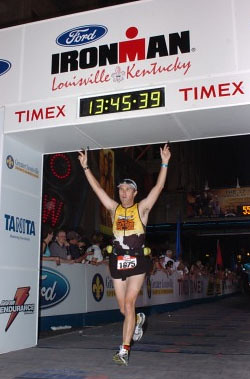A great many triathletes love their data. They love statistics like heart rates, times, distances, elevation, power, etc ad nauseum. Like them, I also love to document my training. Let's face it, I'm a triathlete, an accountant, and a geek. Anyone who wants to compare data, I'm game.
But other than the occassional "I swam this many yards" or "I did this breakthrough workout," there aren't too many graphs, charts, profiles, or other training statistics on this site. In fact, most of what I do is by feeling, and the data I keep is for long term use. Basically, I like to track what I'm doing. In the short term, I really don't care all that much.
I do, however, have many of the toys and gadgets others use. I have a heart rate monitor and cycling computer. I time runs, including various lap points so I can gauge pace and average heart rates. I don't have a power meter, but will gladly succumb to peer pressure if anyone wants to make a donation to the cause. And I put all those little data points into a large variety of training documents.
This year, I returned to tracking run statistics, graphing pace to heart rate over known distances. Combined with a professional training program, an interesting result can now be seen. In February, I completed a 10-mile run at an average pace of 7:42/mile. My average heart rate for the run was 149 bpm. This morning, I completed a 9.1 mile run with a near identical average heart rate of 148 bpm. Average pace? 7:09/mile.
While the runs were different in nature, the data points are telling. Shaving 30 seconds per mile and having a slightly lower average heart rate is the kind of long term trend that motivates further training. And I believe that applies to most of what we track.
Whether it's weight, power on the bike, run/swim pace, or any of a wide variety of other factors, a good approach is to document daily and review infrequently. Today, three months after starting, was the first time I compared data. And the results were drastic and really made my day. If I had compared results every time I ran, the changes would have been less dramatic and actually quite boring.
If you are prone to collecting, reviewing, comparing, and obsessing over data on a regular basis, consider adjusting your focus. Let the graphs take care of themselves, and give yourself a three month reprieve. After that three month period, compare the start and end points and see what improvements have been made. You just might find yourself pleasantly surprised.
Wednesday, May 16, 2007
Subscribe to:
Post Comments (Atom)











1 comment:
[url=http://www.freewebs.com/ciprofloxacin500mg]ciloxan zapalenie ucha
[/url]cipro dairy
ciprofloxacin in dogs
ciproxin tablets
zofran dosage maximum
ciloxan how to use
Post a Comment